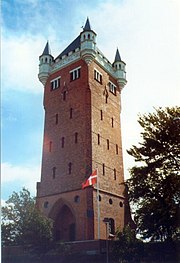Esbjerg
Esbjerg | |
|---|---|
 Esbjerg Main Square with original town hall (now used as tourist office) and statue of founding King Christian IX | |
| Country | Denmark |
| Region | Southern Denmark (Syddanmark) |
| Municipality | Esbjerg |
| Established | 1868 |
| City charter | 1899 |
| Current municipality | 1 January 2007 |
| Government | |
| • Mayor | Johnny Søtrup |
| Area | |
| • City | 742.5 km2 (286.7 sq mi) |
| • Urban | 15 km2 (6 sq mi) |
| Elevation | 11 m (36 ft) |
| Population (2012) | |
| • City | 71,579 |
| • Density | 96/km2 (250/sq mi) |
| Time zone | UTC+1 (CET) |
| • Summer (DST) | UTC+2 (CEST) |
| Postal code | 6700-6715 |
| Area code | (+45) 7 |
| Website | www.esbjerg.dk |
Esbjerg (/ˈɛsbjɜːr/, /ˈɛsbjɜːrɡ/; Danish: [ˈɛsb̥jæɐ̯ˀ]) is a seaport on the west coast of the Jutland peninsula in southwest Denmark: it is the main town of Esbjerg Municipality, the site of its municipal council and with a population of 71,579 (1 January 2012)[1] the fifth largest city in Denmark, and the largest in west Jutland. Its municipality has a population of 115,112.
Geography
The city is situated on the southwestern coast of Denmark, and is a seaport of the North Sea.
History
The city of Esbjerg was established in 1868 as a replacement for the harbour in Altona, which had previously been Denmark's most important North Sea harbour. In 1874 Esbjerg was connected by rail to Fredericia and Varde.

The city has been voted "City of the Year" twice. The first time was in 1997 where the city was awarded the title because of the corporate work between public and private companies. In 2006 the city was again awarded "City of the Year". The second award was given due to the work and support of young talents. The talents in sport, artwork and music have been given good support and given the best facilities to develop their talent even further. The city holds an annual music festival spanning two weekends (nine days) during mid-August and is focused around the central Torvet Square which hosts the main stage. The festival celebrated its 10th anniversary in 2006.
The city was once Denmark's biggest fishing harbour, and the harbour is still an economic driving force in the town. Besides the fishing industry Esbjerg is also the main city for Denmark's oil and offshore activities. Companies like Maersk, Ramboll, Stimwell Services, ABB, Schlumberger, COWI and Atkins all have offshore related activities in the city.
Esbjerg is one of the central towns of the University of Southern Denmark, and also houses a branch of Aalborg University and IT Academy West. The main branch of Profession School – University College West (Danish: Professionshøjskolen University College Vest) can be found in Esbjerg.
Halliburton has an office in Esbjerg.[2]
Landmarks

The Men at Sea (Template:Lang-da) is a monument of four 9 metre (27 feet) tall white males, located to the west of Esbjerg by Sædding Beach . It is located opposite the Fisheries and Maritime Museum, and is one of the area's major tourist attractions, and it is a famous landmark of Esbjerg.
The sculpture was designed by Svend Wiig Hansen and installed on 28 October 1995.[3] It was funded by the government of Esbjerg Kommune, the Kunstfond government and private sponsors to inaugurate the 100th anniversary of the municipality in 1994.
The artist's original idea for the location of the sculpture was Grenen, north of Skagen. The monument can be seen by ferry leaving or entering Esbjerg.
Vestjysk Musikkonservatorium, an Academy of Music and Music Communication, is located in Esbjerg.
Transport

Ferry services connect Esbjerg via Ho Bay to Nordby on the island of Fanø via Nordic Ferry Service,[4] and over the North Sea to Harwich, United Kingdom via DFDS Seaways. Outside the summer period, Smyril Line operate to Tórshavn in the Faroe Islands.
Esbjerg railway station is operated by Danish State Railways. Esbjerg is the western terminus of InterCity trains from Copenhagen (operating every other hour), with the journey taking about three hours. DSB also operates local trains to Fredericia. Arriva operates Vestbanen local trains south to Ribe and Tønder and north to Struer.
The city of Esbjerg is a large transport hub for both rail and road traffic, and is an important port for Danish North Sea oil offshore activity. It has an airport, and is a center for machine building. The municipality has a number of museums, theatres (staging opera, ballet and drama), and several libraries.
Esbjerg Harbour is the second largest harbour in Denmark (after Aarhus Harbour). Esbjerg Harbour serves Maersk Drilling headquarters, and offers the ferry routes Esbjerg–Harwich–Esbjerg, Esbjerg–Faroe Islands–Iceland and the regional commuter Esbjerg–Fanoe–Esbjerg.
Sport
Esbjerg forenede Boldklubber
Esbjerg is home to the Danish football club Esbjerg fB, established in 1924 and known as EfB for short. The club has won the Danish Championship five times, in 1961, 1962, 1963, 1965 and 1979. Esbjerg fB play their home matches at Blue Water Arena. Esbjerg fB also have an ice hockey division called EfB Ishockey.
Other
Rugby in Esbjerg is represented by Esbjerg RK, who play at Guldager Idrætscenter.
Esbjerg also has its own Speedway team, which were crowned Danish League Champions in 2012.
Sister cities
| class="col-break " |
See also
References
- ^ BEF44: Population 1st January, by urban areas database from Statistics Denmark
- ^ "Office Location." Halliburton. Retrieved on 13 January 2009.
- ^ www.arkitekturbilleder.dk
- ^ Nordic Ferry Services : Sejlplan og Priser 2010 : Fanøtrafikken Retrieved 25 February 2010
External links
![]() Media related to Esbjerg at Wikimedia Commons
Media related to Esbjerg at Wikimedia Commons
